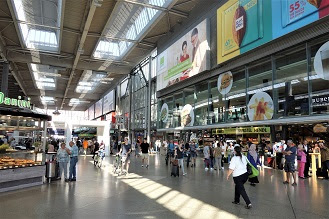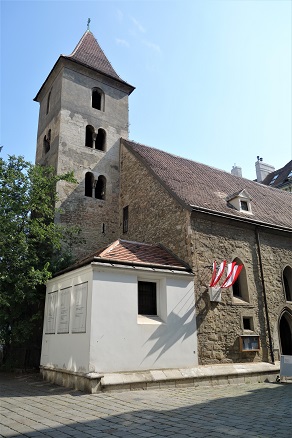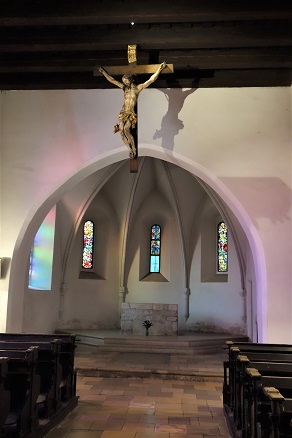After checking into my hotel on Wednesday and getting settled into my room, I ventured out for an early evening stroll in Munich.
Just a few blocks from the hotel is the Karlstor... Karls Gate... one of the medieval entrances to the city.
The gate leads to Kauffingerstrasse, one of the city's main shopping streets. In 1972 for the Summer Olympics it was turned into one Europe's first pedestrian streets. The street is a mixture of modern and old, although no skyscrapers are allowed in the Old Town.
Just a short walk down the street I came to this 18th century church which is called the Bürgersaalkirche (Citizens' Hall Church). It is the worship and meeting place for a men's religious organization.
The door was open, so I went inside to see how Munich's church interiors compare with those of Vienna. The baroque interior was very impressive, but there is a noticeable difference in style. The Bavarian churches tend to be white with gold decoration. They have an lighter, airier feel to them.
Just down the street is another church, St. Michael's. It was built by the Jesuits in the 1500s at the height of the Protestant Reformation, and it was a bastion of the Counter-Reformation.
Once again, white and gold are the predominant colors in the baroque interior.
In the crypts beneath the church are the tombs of the royal family of Wittelsbach, the rulers of Bavaria when it was a separate kingdom.
This commercial building was built in the early 20th century in typical Bavarian style with window boxes full of flowers.
Along the street there are stands selling fresh fruits and vegetables. The fruits and berries all looked very appealing.
I came to the city's main square, the Marienplatz. The spectacular building dominating the plaza is not a church, but the Rathaus, City Hall. It is a fantasy of neo-Gothic architecture that was built in late 1800s.
After having a brief sample of the glories of Munich, it was time for some supper. I ate at one of the many sidewalk cafes along the Kaufingerstrasse. The service was very pleasant although the meal was so-so. Then it was back to the hotel to get a good night's sleep to begin serious sightseeing the next day.
Xmas lights

Saturday, August 31, 2019
On to Munich
On Wednesday I left Vienna and took the train to Munich, the capital of the German state of Bavaria. I checked out of my hotel, and rolled my luggage across the street to the train station. As usual I was early. I had breakfast in the station, and then waited in front of the big blue board waiting for the platform assignment.
My train was supposed to leave at 10:30, but it was fifteen minutes late. (Obviously we aren't in Switzerland.) I was a four hour rail journey to Munich. As we approached Salzburg the landscape became more mountainous.
We arrived at Salzburg station and waited there for perhaps ten minutes while some of the train cars were separated. Part of the train was going to Bregenz, a lakeside city on the border with Switzerland.
As we pulled out of the station I was able to snap a photo of Salzburg Castle.
Salzburg is very close to the German border, so I assume that the subsequent photos are of the Bavarian Alps.
At 2:45 in the afternoon we pulled into Munich's main train station.
My hotel, City Aparthotel, is within rolling distance of the train station, although not as close as my place in Vienna was.
My room is comfortable, clean and spacious...
yet this is a very odd place. To get to my room I have to go through a courtyard to another building. I don't think the rooms have any soundproofing. Every sound in the hallway or the courtyard reveberates. Every close door sounds as if it is being slammed shut. There are a lot of families staying here with crying babies, and screaming kids. Some of the adult guests don't understand the concept of an "indoors voice" either. The price was right, but if I were to return to Munich I would not pick this hotel.
My train was supposed to leave at 10:30, but it was fifteen minutes late. (Obviously we aren't in Switzerland.) I was a four hour rail journey to Munich. As we approached Salzburg the landscape became more mountainous.
We arrived at Salzburg station and waited there for perhaps ten minutes while some of the train cars were separated. Part of the train was going to Bregenz, a lakeside city on the border with Switzerland.
As we pulled out of the station I was able to snap a photo of Salzburg Castle.
Salzburg is very close to the German border, so I assume that the subsequent photos are of the Bavarian Alps.
At 2:45 in the afternoon we pulled into Munich's main train station.
My hotel, City Aparthotel, is within rolling distance of the train station, although not as close as my place in Vienna was.
My room is comfortable, clean and spacious...
yet this is a very odd place. To get to my room I have to go through a courtyard to another building. I don't think the rooms have any soundproofing. Every sound in the hallway or the courtyard reveberates. Every close door sounds as if it is being slammed shut. There are a lot of families staying here with crying babies, and screaming kids. Some of the adult guests don't understand the concept of an "indoors voice" either. The price was right, but if I were to return to Munich I would not pick this hotel.
Friday, August 30, 2019
Finishing Up Vienna
Tuesday was my last day in Vienna, and I wanted to spend the day simply wandering around the old part of the city. Once again I was enchanted by the architectural beauty of this place.
I figured that I had already seen enough churches, but during my wanderings I kept running across more. I would enter and be astounded. Is there no end to the baroque splendor of this city?
Here is the Jesuit church...
The "trompe l'oeil" painting on the ceiling makes you think there is a dome where there is none.
Soon I had reached the Danube Canal, the northern limit of the Old City.
This is the oldest part of the old. It was around here that the Romans had founded their settlement of Vindobona. There are still a few streets that look more medieval than baroque.
One church that I was searching for was St. Ruprecht's Church. My former student Meredith mentioned that she had seen it some years ago on her first trip to Europe and was impressed by its antiquity. This Romanesque structure is the oldest church in Vienna. Its founding may date back to the 9th century although the building has been rebuilt and altered several times in its history. The simple exterior and interior are a striking contrast to the grandeur of the city's baroque churches.
A few blocks farther and I had come to the Judenplatz… the Jewish Plaza. This neighborhood was once the Jewish ghetto in medieval times.
The austere structure in the plaza is the memorial to the 65,000 Viennese Jews who were murdered in the Holocaust. The memorial stands on the site where the synagogue of medieval Vienna once stood.
I soon reach another square. This one is called the Am Hof.
This lovely building facing the Am Hof served as the armory and then as the headquarters for Vienna's fire brigade.
There are many horse drawn carriages that take tourists on a tour of the old city. In spite of all the horses, I never saw one bit of dung on the streets.
A street vendor selling fresh fruit.
OK, just one more church. This one is part of a Benedictine monastery and is called the Scottish Church. A sign with the church's history explained that the monastery was founded by Irish monks. In the Middle Ages Ireland was referred to as "Scotia maior"... larger Scotland. The name Scottish Church or Our Lady of the Scots stuck. The monastery is the oldest in Vienna, founded in 1155. Obviously the structure has been much modified since then.
The interior of the church did not disappoint... another baroque masterpiece.
By this time it was time for a break and something to eat, so I went back to Demel, that wonderful pastry shop. It was a hot day, so I ordered cold chocolate instead of hot, and this time I had TWO pastries... some kind of strawberry confection, and apple strudel. After all, who knows when I will get back to Vienna, and, besides, I deserved to indulge after walking all morning.
In the afternoon I took the tram to the city park.
At the edge of the park is the Kursalon, a small concert hall where Johann Strauss used to perform with his orchestra.
Nearby in the park is a monument to Johann Strauss, the Waltz King who will forever be identified with Vienna.
It was late afternoon, and I needed to return to my hotel and pack my bags. Farewell to Vienna. The next day I was headed to Germany.
I figured that I had already seen enough churches, but during my wanderings I kept running across more. I would enter and be astounded. Is there no end to the baroque splendor of this city?
Here is the Jesuit church...
The "trompe l'oeil" painting on the ceiling makes you think there is a dome where there is none.
A short distance away is the Dominican church...
Soon I had reached the Danube Canal, the northern limit of the Old City.
This is the oldest part of the old. It was around here that the Romans had founded their settlement of Vindobona. There are still a few streets that look more medieval than baroque.
One church that I was searching for was St. Ruprecht's Church. My former student Meredith mentioned that she had seen it some years ago on her first trip to Europe and was impressed by its antiquity. This Romanesque structure is the oldest church in Vienna. Its founding may date back to the 9th century although the building has been rebuilt and altered several times in its history. The simple exterior and interior are a striking contrast to the grandeur of the city's baroque churches.
A few blocks farther and I had come to the Judenplatz… the Jewish Plaza. This neighborhood was once the Jewish ghetto in medieval times.
The austere structure in the plaza is the memorial to the 65,000 Viennese Jews who were murdered in the Holocaust. The memorial stands on the site where the synagogue of medieval Vienna once stood.
I soon reach another square. This one is called the Am Hof.
This lovely building facing the Am Hof served as the armory and then as the headquarters for Vienna's fire brigade.
There are many horse drawn carriages that take tourists on a tour of the old city. In spite of all the horses, I never saw one bit of dung on the streets.
A street vendor selling fresh fruit.
OK, just one more church. This one is part of a Benedictine monastery and is called the Scottish Church. A sign with the church's history explained that the monastery was founded by Irish monks. In the Middle Ages Ireland was referred to as "Scotia maior"... larger Scotland. The name Scottish Church or Our Lady of the Scots stuck. The monastery is the oldest in Vienna, founded in 1155. Obviously the structure has been much modified since then.
The interior of the church did not disappoint... another baroque masterpiece.
By this time it was time for a break and something to eat, so I went back to Demel, that wonderful pastry shop. It was a hot day, so I ordered cold chocolate instead of hot, and this time I had TWO pastries... some kind of strawberry confection, and apple strudel. After all, who knows when I will get back to Vienna, and, besides, I deserved to indulge after walking all morning.
In the afternoon I took the tram to the city park.
At the edge of the park is the Kursalon, a small concert hall where Johann Strauss used to perform with his orchestra.
Nearby in the park is a monument to Johann Strauss, the Waltz King who will forever be identified with Vienna.
It was late afternoon, and I needed to return to my hotel and pack my bags. Farewell to Vienna. The next day I was headed to Germany.
A Night at the Opera
I mentioned a couple posts ago that every evening in the months of July and August, a movie is presented on a big screen in front of the Vienna City Hall. On Monday evening after my day trip to Bratislava, I made a point of heading over for that evening's film. They were going to show a movie of an outdoor concert that had been given earlier this summer in celebration of the 150th anniversary of the Vienna State Opera.
I arrived about an hour ahead of time, and fortunately there were still plenty of good seats.
Here is a small portion of the film. The opera orchestra and chorus are performing "The Chorus of the Hebrew Slaves" from Verdi's opera "Nabucco".
For the finale of the concert, all of the soloists who had performed were joined by the orchestra and chorus for the drinking song from Verdi's "La Traviata".
The young fellow that was seated next to me was from Mexico City. He is a composer, and he had just finished taking a course here. He is hoping to be accepted to do his post-graduate work in composition in Vienna. Before and after the film we conversed in Spanish. It's a small world.
When the movie was over, the food stalls on the plaza in front of city hall were doing a brisk business. I stopped at one that serves traditional Austrian food. I ordered spätzle with cheese and onions. My mother used to make spätzle, and I suppose that she learned to make them from her Swiss grandmother. These spätzle were as good as my mom's!
I arrived about an hour ahead of time, and fortunately there were still plenty of good seats.
The young fellow that was seated next to me was from Mexico City. He is a composer, and he had just finished taking a course here. He is hoping to be accepted to do his post-graduate work in composition in Vienna. Before and after the film we conversed in Spanish. It's a small world.
When the movie was over, the food stalls on the plaza in front of city hall were doing a brisk business. I stopped at one that serves traditional Austrian food. I ordered spätzle with cheese and onions. My mother used to make spätzle, and I suppose that she learned to make them from her Swiss grandmother. These spätzle were as good as my mom's!
It was a great evening!
Subscribe to:
Comments (Atom)


















































